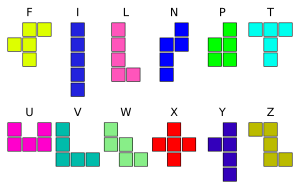Pentomino facts for kids
A pentomino is a flat shape made from five squares that are all the same size. These squares are connected side-by-side, like puzzle pieces. Think of them as shapes you can make with five LEGO bricks if they were flat! Pentominoes are fun to use in puzzles and games. They were created by Solomon W. Golomb. You might have seen them in books like Chasing Vermeer and The Wright 3.
Contents
What Are Pentominoes?
A pentomino is a special kind of 2D (two-dimensional) shape. This means it's flat, like a drawing on a piece of paper. Each pentomino is made up of exactly five squares. These squares must touch each other along their full sides, not just at a corner. If you can rotate or flip a shape and it looks the same as another, it's considered the same pentomino.
The Twelve Unique Shapes
There are exactly twelve different pentomino shapes. Each one is unique and cannot be turned or flipped to match another. People often name these shapes after letters of the alphabet that they look like.
The twelve pentominoes are:
- F
- I
- L
- P
- N
- T
- U
- V
- W
- X
- Y
- Z
Who Invented Pentominoes?
The idea of pentominoes was made popular by a mathematician named Solomon W. Golomb. He introduced them to the world in 1953. Since then, they have become famous in many puzzles and games. Golomb also studied other shapes made from squares, like trominoes (3 squares) and tetrominoes (4 squares).
How Are Pentominoes Used?
Pentominoes are often used in puzzles and games. A common challenge is to fit all twelve pentominoes together to form a larger rectangle. For example, you can make a 6x10, 5x12, 4x15, or 3x20 rectangle using all 12 shapes. This is a fun way to test your spatial reasoning skills!
They are also used in:
- Board games: Some games use pentominoes as playing pieces.
- Computer games: You might find pentomino-like puzzles in video games.
- Educational tools: Teachers sometimes use them to help students learn about geometry and problem-solving.
Solving pentomino puzzles can be tricky but very rewarding. It helps you think about how shapes fit together in different ways.
See also
 In Spanish: Pentominó para niños
In Spanish: Pentominó para niños


